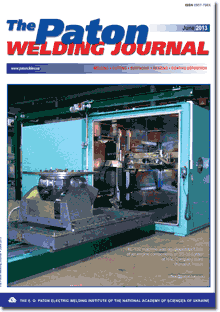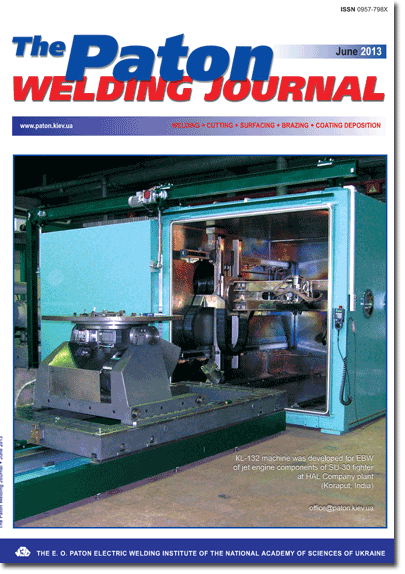
The Paton Welding Journal, 2013, #6, 34-37 pages
AdmiralS.O.MakarovNationalShipbuildingUniversity, Nikolaev, Ukraine. E-mail: simutenkov@inbox.ru
Abstract
Transverse oscillations of the electrode in automatic submerged arc surfacing are one of the ways of decrease in penetration depth and share of base metal in deposited one. These oscillations can be created by generating of high-frequency transverse pulsed movements of electrode wire using a specially designed electromechanical generator. The aim of this work is to evaluate the effect of high-frequency low-amplitude transverse pulsed movements of electrode wire on geometry of deposited bead and efficiency of the surfacing process. Deposition of beads was made on plates of low-carbon structural steel with electrode wire Sv-0.8A of 2 mm diameter under flux AN-348A. The pulsed electrode movements at 0.25-5 kHz frequency were generated along the surfacing direction. It was found that with increase in frequency the penetration depth of base metal and bead width are decreased, while the height of bead is increased, in addition the surfacing efficiency is also changed. The nature of change in the mentioned parameters depends on mode of pulsed effect on electrode wire, i.e. the presence or absence of resonance. The most significant change in geometry of the deposited bead is observed in the region of frequencies of the first resonance (0.55-0.75 kHz), namely depth of penetration and share of base metal in deposited one is 3 times decreased. The maximum increase in efficiency is occurred in the region of the second resonance (3.75-3.85 kHz), the coefficient of electrode melting is increased by 10-20 % as compared with surfacing without a pulsed effect. 10Ref., 1 Table, 4 Figures.
Keywords: automatic arc surfacing, low-carbon structural steels, high-frequency pulsed movement, mechanical generator, geometry of deposited bead
Received: 04.02.13
Published: 28.06.13
References
1. (1974) Technology of fusion electric welding of metals and alloys. Ed. by B.E. Paton. Moscow: Mashinostroenie.
2. Najdenov, A.M. (1998) Calculation of electrode wire melting rate in mechanized methods of arc welding. Svarochn. Proizvodstvo, 6, 10-14.
3. Tarasov, N.M. (1984) Energy calculation of electrode metal drop detachment under action of pulse of external electromagnetic field. Avtomatich. Svarka, 6, 21-25.
4. Lebedev, V.A. (2008) Aspects of choice of electric arc and automatic welding equipment with pulsed feed of electrode wire. Svarochn. Proizvodstvo, 5, 45-49.
5. Razmyshlyaev, A.D., Mironova, M.V. (2011) Efficiency of electrode wire melting in submerged arc surfacing under action of transversal magnetic field. Visnyk Donbas. Derzh. Mashynobud. Akademii, 1, 142-147.
6. Lebedev, V.A., Kuzmin, I.S., Novgorodsky, V.G. et al. (2002) Control of mechanized CO2 welding process using parameters of electrode metal transfer. Svarochn. Proizvodstvo, 5, 6-14.
7. Alov, A.A., Vinogradov, V.S. (1958) Effect of electrode vibration on arc welding process and properties of welds. Ibid., 9, 19-22.
8. Dragan, S.V., Simutenkov, I.V. (2011) Development of device for control of weld geometric parameters in automatic submerged arc surfacing. Zbirnyk Nauk. Prats NUK, 3, 59-64.
9. (1970) Physics and technique of power ultrasound. Vol. 3: Physical principles of ultrasonic technology. Ed. by L.D. Rozenberg. Moscow: Nauka.
10. (1970) Physics and technique of power ultrasound. Vol. 1: Supplies of power ultrasound. Ed. by L.D. Rozenberg. Moscow: Nauka.
AS = «Automatic Welding» - 6 issues per year;
TPWJ = «PATON WELDING JOURNAL» - 12 issues per year;
SEM = «Electrometallurgy Today» - 4 issues per year;
TDNK = «Technical Diagnostics and Non-Destructive Testing» - 4 issues per year.
| 2013 №06 (05) | 2013 №06 (07) |

The Paton Welding Journal, 2013, #6, 34-37 pages
AUTOMATIC SUBMERGED ARC SURFACING OF STRUCTURAL STEELS WITH TRANSVERSE HIGH-FREQUENCY MOVEMENTS OF ELECTRODE
Zh.G. GOLOBORODKO, S.V. DRAGAN and I.V. SIMUTENKOV
AdmiralS.O.MakarovNationalShipbuildingUniversity, Nikolaev, Ukraine. E-mail: simutenkov@inbox.ru
Abstract
Transverse oscillations of the electrode in automatic submerged arc surfacing are one of the ways of decrease in penetration depth and share of base metal in deposited one. These oscillations can be created by generating of high-frequency transverse pulsed movements of electrode wire using a specially designed electromechanical generator. The aim of this work is to evaluate the effect of high-frequency low-amplitude transverse pulsed movements of electrode wire on geometry of deposited bead and efficiency of the surfacing process. Deposition of beads was made on plates of low-carbon structural steel with electrode wire Sv-0.8A of 2 mm diameter under flux AN-348A. The pulsed electrode movements at 0.25-5 kHz frequency were generated along the surfacing direction. It was found that with increase in frequency the penetration depth of base metal and bead width are decreased, while the height of bead is increased, in addition the surfacing efficiency is also changed. The nature of change in the mentioned parameters depends on mode of pulsed effect on electrode wire, i.e. the presence or absence of resonance. The most significant change in geometry of the deposited bead is observed in the region of frequencies of the first resonance (0.55-0.75 kHz), namely depth of penetration and share of base metal in deposited one is 3 times decreased. The maximum increase in efficiency is occurred in the region of the second resonance (3.75-3.85 kHz), the coefficient of electrode melting is increased by 10-20 % as compared with surfacing without a pulsed effect. 10Ref., 1 Table, 4 Figures.
Keywords: automatic arc surfacing, low-carbon structural steels, high-frequency pulsed movement, mechanical generator, geometry of deposited bead
Received: 04.02.13
Published: 28.06.13
References
1. (1974) Technology of fusion electric welding of metals and alloys. Ed. by B.E. Paton. Moscow: Mashinostroenie.
2. Najdenov, A.M. (1998) Calculation of electrode wire melting rate in mechanized methods of arc welding. Svarochn. Proizvodstvo, 6, 10-14.
3. Tarasov, N.M. (1984) Energy calculation of electrode metal drop detachment under action of pulse of external electromagnetic field. Avtomatich. Svarka, 6, 21-25.
4. Lebedev, V.A. (2008) Aspects of choice of electric arc and automatic welding equipment with pulsed feed of electrode wire. Svarochn. Proizvodstvo, 5, 45-49.
5. Razmyshlyaev, A.D., Mironova, M.V. (2011) Efficiency of electrode wire melting in submerged arc surfacing under action of transversal magnetic field. Visnyk Donbas. Derzh. Mashynobud. Akademii, 1, 142-147.
6. Lebedev, V.A., Kuzmin, I.S., Novgorodsky, V.G. et al. (2002) Control of mechanized CO2 welding process using parameters of electrode metal transfer. Svarochn. Proizvodstvo, 5, 6-14.
7. Alov, A.A., Vinogradov, V.S. (1958) Effect of electrode vibration on arc welding process and properties of welds. Ibid., 9, 19-22.
8. Dragan, S.V., Simutenkov, I.V. (2011) Development of device for control of weld geometric parameters in automatic submerged arc surfacing. Zbirnyk Nauk. Prats NUK, 3, 59-64.
9. (1970) Physics and technique of power ultrasound. Vol. 3: Physical principles of ultrasonic technology. Ed. by L.D. Rozenberg. Moscow: Nauka.
10. (1970) Physics and technique of power ultrasound. Vol. 1: Supplies of power ultrasound. Ed. by L.D. Rozenberg. Moscow: Nauka.
The cost of subscription/purchase order journals or individual articles
| Journal/Currency | Annual Set | 1 issue printed |
1 issue |
one article |
| AS/UAH | 1800 UAH | 300 UAH | 300 UAH | 150 UAH |
| AS/USD | 192 $ | 32 $ | 26 $ | 16 $ |
| AS/EUR | 180 € | 30 € | 25 € | 15 € |
| TPWJ/UAH | 7200 UAH | 600 UAH | 600 UAH | 280 UAH |
| TPWJ/USD | 384 $ | 32 $ | 26 $ | 16 $ |
| TPWJ/EUR | 360 € | 30 € | 25 € | 15 € |
| SEM/UAH | 1200 UAH | 300 UAH | 300 UAH | 150 UAH |
| SEM/USD | 128 $ | 32 $ | 26 $ | 16 $ |
| SEM/EUR | 120 € | 30 € | 25 € | 15 € |
| TDNK/UAH | 1200 UAH | 300 UAH | 300 UAH | 150 UAH |
| TDNK/USD | 128 $ | 32 $ | 26 $ | 16 $ |
| TDNK/EUR | 120 € | 30 € | 25 € | 15 € |
AS = «Automatic Welding» - 6 issues per year;
TPWJ = «PATON WELDING JOURNAL» - 12 issues per year;
SEM = «Electrometallurgy Today» - 4 issues per year;
TDNK = «Technical Diagnostics and Non-Destructive Testing» - 4 issues per year.

